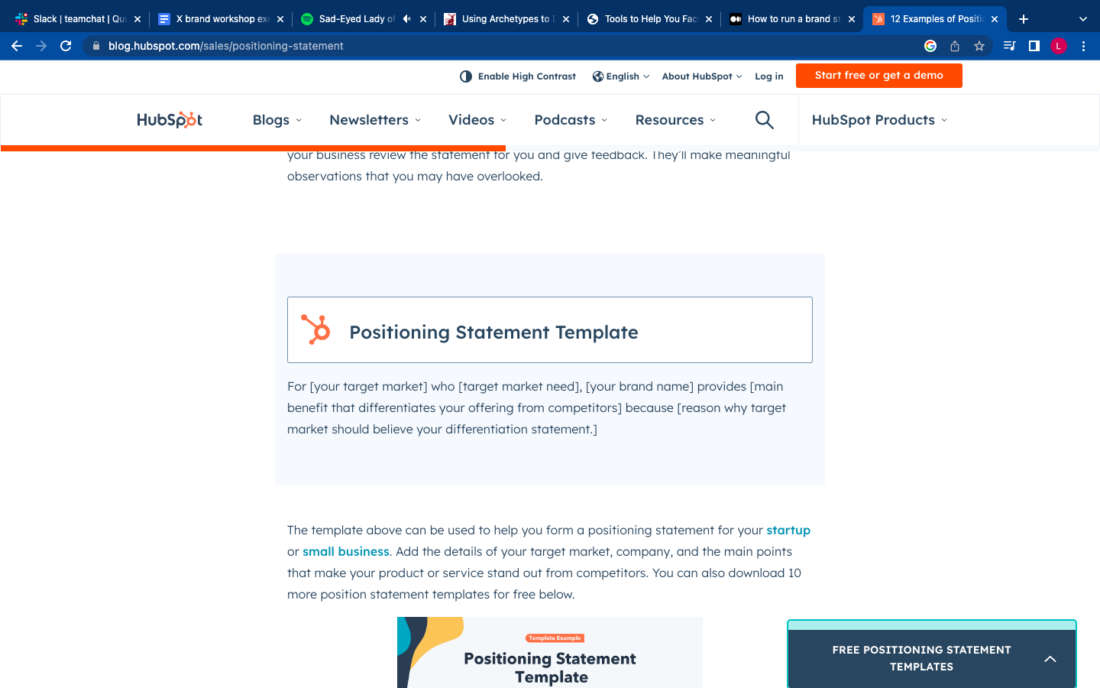For a brand strategy to succeed, everyone should be on the same page about how their ideal business should look. If your business doesn’t have a clear vision of itself, how is its target audience supposed to understand its purpose? This is obvious, but in reality, a lot of companies struggle to achieve a coherent brand identity and often fall for these common myths about content and marketing strategy.
But it doesn’t have to be this way. In fact, there are some super easy and fun ways to explore this topic and visualize your ideal business as a collective. Through brand strategy workshop exercises, your team can share how they view the current business and explore what needs to change to achieve your business goals.

This will not only improve your marketing strategies and, therefore, your brand experience, but it’ll highlight initiatives that should be put in place to improve your user experience. If you want some top tips on how to make your brand memorable for your users, check out our previous blog post.
So next time you’re having a brand strategy meeting, whether on zoom or in person, try out a few of these suggestions.
Karaoke
Don’t worry. We’re not suggesting a work night out embarrassing yourselves at a karaoke club. Instead, we’re asking you to consider what would happen if your brand did this. Stay with me.
What would your ideal business’s go-to song be?
Get everyone to choose one song they think the business would sing. Share the suggestions and ask why. Then ask:
What would your current business’s go-to song be?

Why?
This says a lot about what people think of your current business’s persona and tone of voice (pun intended). If your ideal business’s go-to is a disco banger like Diana Ross’s ‘I’m coming out’ then you can visualize your brand as powerful, confident, fun, and an authority in the industry. If the current song is a more low-key, downbeat ‘Creep’ by Radiohead, then it’s clear some rebranding might be necessary.
Now, I know these are extreme examples. But this is a fun way to visualize your brand personality through music, and it can tell you plenty about how you’re currently coming across.
Draw them
Your ideal business is a person. Draw them! Include their interests, thought bubbles, pets they’d have next to them, and the house they live in. The more detail and the more creative, the better!
Encourage people to experiment. This isn’t an exercise to find out who’s the best at drawing but an insight into how your colleagues visualize your brand.

Why?
If the drawings turn out similar, you’re onto a winner! If not, then you know there’s work to do. Compare the drawings and ask for the reasons behind the choices. You’ll soon figure out a consensus of your ideal business and have something to work towards. By visualizing aspects of your business, like its thoughts, house, and pets, you can start getting into the details. Like the way it should run, its core values, and what it stands for.
Keywords
If drawing isn’t your vibe, then try the same but with keywords. Give everyone 5 sticky notes and ask them to write a keyword on each that best describes the brand vision you want to achieve.
These could be anything from ‘fun’ to ‘experimental’ to ‘professional’. It will differ depending on your brand’s purpose.

Why?
These keywords spark conversation. What do they mean to you? What do they mean to the business? Which words can be applied to your current business, and which are you still trying to achieve?
Once you establish the answers to these questions, you’ll build a clear image of your brand’s values. You can then structure content curation, digital marketing, and statements around these. It’ll also highlight whether everyone is on the same page. If not, then continuing some more brand-building exercises may be necessary.
Comparison game
Fun and easy to visualize, comparing your ideal business to concrete or abstract objects can help everyone understand the kind of brand persona you want to create. Here are some examples:
If your ideal business were an animal, what animal would it be?
Repeat this style of questioning with the following:
- A vehicle
- A celebrity
- A social media platform
- A color
- A music genre
- A season
- An emotion
Why?
Let’s look at an example to understand this exercise. Let’s say my business is a progressive environmental consultancy. My company advises other businesses on how to make changes to how they run in order to reduce their impact on the environment. But I want my brand voice to be progressive, rebellious, and exciting because my business’s values focus on addressing and improving climate change, not just making money. Similar to Beyond Meat’s social media presence:
https://twitter.com/BeyondMeat/status/1580282832072544257
Here are a few of my answers with an explanation:
Color:
Green. This will be a clear indication to my audience that my focus is on the environment.
Music Genre:
Punk. It’s rebellious, it’s exciting, and it demands change.
Season:
Spring. It symbolizes new beginnings.
With these answers, a clear vision of my ideal business begins to take shape. I can compare it to my current business and see what needs to change. You can even use the answers to think about your marketing strategy. Are you using the right color palette for your brand’s design? Are you sharing content that aligns with your values and morals? Is your social media presence professional or rebellious?
Newspaper headlines
It’s 5 years down the line. After working hard on achieving your goals, your business is featured in prominent newspaper headlines. What do they say? Come up with three headlines that you’d want to be written about your ideal business.
Why?
When someone asks you what your targets are, you may find yourself a bit stumped. This is an easy and effortless way to set out your aims and targets. This creative exercise draws out what you intend the most for your business. This will offer you clarity and a focus on your priorities as a brand.
Create your brand archetype
The mother of all branding exercises: Brand archetypes are all about creating an emotional tie with your audience. Look at an archetype wheel together and collectively discuss which one would best suit your brand.
Here’s a great template of the 12 archetypes with examples of different brands’ positioning based on the guiding principles of their business and the demographic to which they are trying to appeal.

Why?
By producing a persona that plays to human emotions, you can build a narrative that will draw your audience in. Once you establish the character your brand stands with, it will become a lot easier to focus your strategists and decision-makers on a particular marketing plan.
This will not only attract a wider audience, but it’ll play to the emotions of your existing following, improving their brand loyalty. This is useful if you already have a following but are struggling with engagement or are a startup ready to begin a marketing campaign.
If you want to learn more ways to humanize your brand, check out our previous blog.
Create a mission statement
A Mission statement is a short and often quite formal summary of why your business exists. It sounds easy, but it can be pretty tricky. Summarizing a whole company in a snappy, conclusive tagline takes a lot of thought.
So, crack out your whiteboard. Start off by having everyone suggest what they think the brand’s purpose is. You’ll soon see some recurring words and phrases. Start circling the ones you agree on as the most important and the most repeated.

It’s often useful to have everyone spend some time alone coming up with a statement that uses those keywords and phrases. After you have shared them, vote as a company on which one best describes your brand’s purpose.
Let’s take a look at some examples:
JetBlue: “To inspire humanity – both in the air and on the ground.”
Tesla: “To accelerate the world’s transition to sustainable energy.”
Asos: “To become the number 1 fashion destination for 20-somethings globally.”
LinkedIn: “To connect the world’s professionals to make them more productive and successful.”
Twitter: “To give everyone the power to create and share ideas and information, instantly without barriers.”

Why?
This is not only helpful for you as a business to make your goals clear but also for your audience. A quick and clear insight into what your company stands for and why it exists means your following can decide whether they want to use your services.
As you can see from the examples, a good mission statement will target and appeal to its audience directly. For LinkedIn, it’s the world’s professionals; for Asos, it’s 20-somethings. This gives your customers a sense of belonging.
However, aside from a marketing perspective, it unites your company. It helps all colleagues visualize your brand and know who and what they work for. Imagine Google. A huge company with workers all around the world. Without their clear statement: “To organize the world’s information and make it universally accessible and useful.” uniting a workforce that extensive could be difficult, but their mission statement clarifies what they do and why they do it.
Plot a competitive landscape
An invaluable resource of research is your competitors. You can clearly see where your business stands amongst the rest by plotting them onto a competitive landscape.
You can replace the X and Y axis with whatever is most suitable for your brand. For example, if you were a fashion brand, maybe the X axis would remain price, but the Y axis could be replaced with quality.
Once you have taken the time to analyze your competitors and plot them on the graph, find a place for your business.

Why?
This is a great exercise for honesty. To visualize your ideal business, you must accept the pitfalls of your current business. By seeing where you stand amongst your competitors, you will learn where to focus your efforts.
Knowing the competitors performing better than you will give you unlimited resources to help improve your brand. You can leverage their audience, take inspiration from their graphic design, and learn from their user interface.

You can keep the competitive landscape you created and set goals from it. Revisit it each quarter and discuss whether you feel your position has changed. This is a great exercise to motivate your team and visualize your ideal business together.
From here, create a positioning statement
Once you know where you stand amongst your competitors, it’s time to set yourself apart. Ask the group the following questions and write up the answers:
What does your business offer that other competitors cannot?
What consumer needs do you fulfill in a way that no other competitor does?
Similarly to the mission statement, identify repetitions, keywords, and key ideas. Start creating your positioning statement, and remember that this is not a customer-facing exercise, unlike your mission statement. This is primarily for your business to understand its value within the market.
If you’re struggling with how to format it, use this handy template:

Why?
Your position impacts everything. It will direct your brand strategy, indicate your target audience, and underpin your values as a business. This unites your workforce and gives them something to refer back to when making key decisions for branding.
This or that
‘This or that’ is a great way to visualize multiple different aspects of your business. It can help create a coherent identity when it comes to all aspects of your marketing strategy, like content writing, social media presence, and brand personality.
Let’s take content writing as an example. Gather your content team and give them different blog titles to choose from:
- “10 Ways You Can Nail a Branding Strategy Meeting” or “How to Structure and Lead a Strategy Meeting”
- “Our Favorite Marketing Top Tips” or “How to Improve a Business’s Content Marketing”

Why?
Clearly, there is an informal, fun, and personal brand voice and a more professional and formal voice to choose from. Depending on your branding strategy, one will be more appropriate than the other.
You can repeat this with images of fonts, social media posts, and colors; the list is endless. Taking real-life examples makes it easier to visualize your brand identity. It will also offer insights as to what may need to change if you want your brand to evolve. For example, if you’re aiming for a quirky and interesting social media presence, but your content team chose to share the blogs with more professional titles, you know that you need to work on creating a brand voice that reflects your goals.
Know who your brand is
I’m sure you have started analyzing areas to improve just from reading through these ideas. Once you work together and action these workshop exercises, you’ll be able to move forward as a coherent team with a clear vision of a single goal.
It is exciting to see your brand identity come together, and through these fun activities, I’m sure your team will begin to work more effectively and efficiently.
So, sit back after your brand workshop meeting and watch the customers roll in. You could be part of something truly special.









